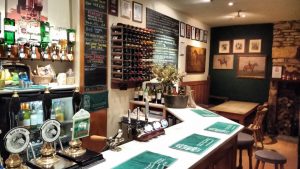I approached the Horse & Groom at Bourton on the Hill in the Cotswolds, on a dimming autumnal evening, with “child in the toy shop” level of anticipation.
It had just been voted Pub of the Year in The Good Pub Guide 2016. The guide extolled it as “Handsome, Georgian, honey-coloured stone inn”.
It’s one of the joys of touring in Britain, arriving in the half-light at a warm and welcoming country pub for an overnight stay, and to experience features such as these – “wooden chairs, settles, cushioned wall and window seats and tables on bare boards, a woodburning stove in a stone fireplace”, as the Guide lists them.
The Horse & Groom met our high hopes, from the good local beer to the home-made flapjacks in our room. (And free wifi, of course, though it hardly merits a mention these days.) The winning feature, though, is the food. Pub fare is now so much better, and more inventive, than anything (most) hostelries offered in the past.
The blackboard in the photo shows the chef’s ideas for the day. You are presented with a tantalising choice the moment you walk through the door. The policy of sourcing ingredients locally and responsibly is now commonplace in country pubs and restaurants, but is still worth noting.
As well as locally-raised meat, poultry and dairy products, they serve fish “wherever possible line-caught by small [West Country] dayboats to minimize the impact on the marine environment.” Even now too few restaurants give this sustainability message. If you make the point with meat, do the same with fish and shellfish.
The same applied to the choice of good, properly-fashioned (unadulterated, natural ingredients) beer. Again, the explosion in the range of beers has been phenomenal. On our visit they offered “Hook Norton Lion and Wickwar Coopers WPA on handpump, local Hogan’s farm cider and locally brewed lagers from the Cotswold Brewing Company.”
The pub also served 22 wines by the glass. This gives you the chance to sample different wines without committing to a bottle. And, if this matters to you, you are not so tempted to over-indulge.
Stay or simply call in – the Horse & Groom is a fine example of the recent revival of the independent hostelry, and in my view one of the singular successes of British tourism recently.
The pub is 2.3 miles from Moreton in Marsh, which has a railway station on the line from Oxford and Paddington. That’s a possible walk during daylight, although you might prefer to take a taxi.
What to see around the Horse & Groom.
Batsford Arboretum
Batsford Arboretum is a short walk away. There is a fabulous collection of trees to see, some of them very old, in one of the finest botanical collections in the UK. www.batsarb.co.uk
There are some especially precious new shoots at the arboretum. It’s scarcely credible, but the atomic bomb didn’t kill everything in central Hiroshima in 1945. A few, favoured trees survived. Batsford’s head gardener was sent seeds from Ginkgo and an Ilex Rotunda “survivor trees” in 2015. Some have already germinated in the nursery, and saplings should be in the grounds soon.
The National Trust’s Snowshill.
The fortunes men made from wool fuelled a grand house-building spree in the Cotswolds, from mediaeval times onwards. Many survive and you may visit them. The National Trust’s Snowshill contains a series of intermingling and intimate little walled-off gardens, nooks and hidden bowers designed by the owner Charles Wade in the early 1900s.
The C16th manor house contains his treasure trove of 22,000 objects, from tiny toys to Samurai armour, in a magical subdued light. Nearby is Sudeley Castle, a restored Tudor manor. In 1535 Henry VIII planned of the dissolution of the monasteries while staying here. The last of his wives, Katherine Parr, is buried in a chapel in the grounds.
Cotswolds walls.
One ubiquitous feature of the Cotswolds is the dry stone wall, the colour of rich butter. All praise to the Great Wall of China, but there are just as many miles (4000) here, in a complex vertical jigsaw, made from limestone from local quarries.
With changes in farming – they are not so necessary to contain sheep and cattle – part of the walls’ incidental function now is to serve as an intricate joined-up nature reserve. They support a botanical bonanza of such small-scale delights as cushion moss, pennywort, stonecrop, polypody and wall rue.

